Silver arowana (lat. Osteoglossum bicirrhosum) is a tropical freshwater fish of the Osteoglossidae family. Osteoglossidae genus appeared during the Jurassic period and hasn’t changed much during the last 150 million years. It’s a popular tank fish, which is often kept in zoos, public and amateur tanks around the world. In the East countries, it is a symbol of wealth and prosperity. Some fish species can rich dozen thousand dollars.
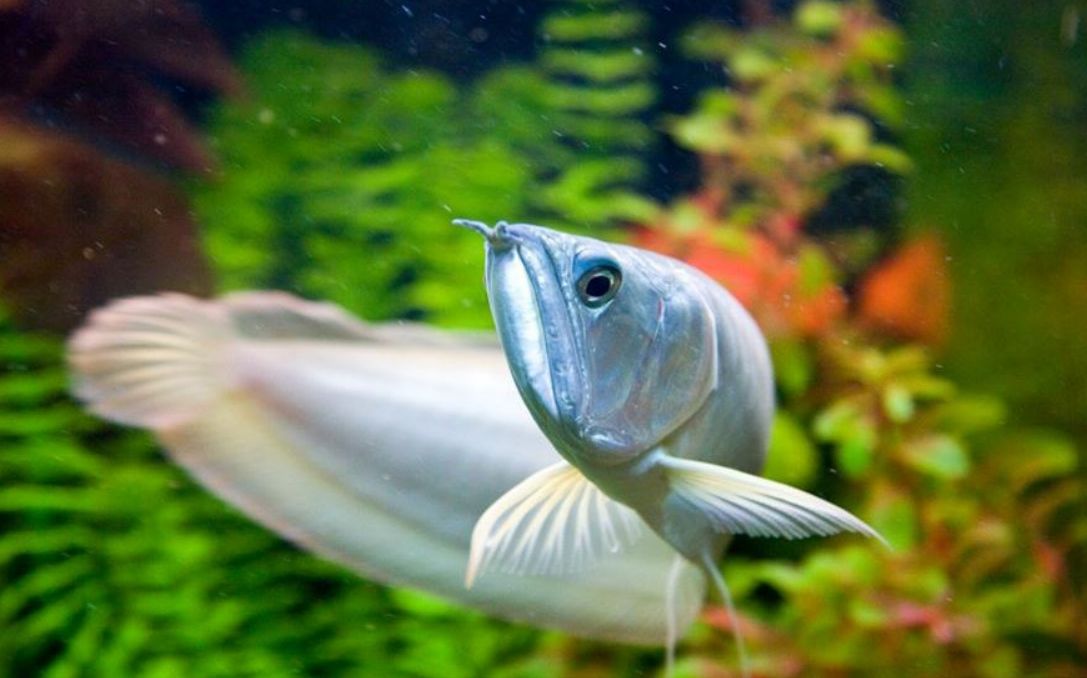
Contents
Habitat in the wild
The Silver Arowana, scientifically known as Osteoglossum bicirrhosum, belongs to the family Osteoglossidae. This family includes various species of freshwater fish commonly known as “Arowanas.” This family of fish is known for its unique characteristics, including its bony tongue, which is actually a bony plate on the floor of its mouth.
Osteoglossidae family representatives can be encountered almost in all continents: South America, Africa, Australia, and South-East Azia. This is due to the fact that the fish is ancient. During the Jurassic period, Arowana predecessors inhabited supercontinent Gondwana that in after years divided into the continents which we know now.
The fish is native to South American river basins – such as the Amazon river, Rupununi, Orinoco, and Essequibo. The fish was introduced in North America several times silver arowana was caught in the USA, in ponds of different states. Fish inhabits backwaters and inshore zones of rivers and lakes with water temperature about +24…+30 °C. Each year during the overflow of the Amazon river, this fish swims into flooded bottomland forests. In the wild, it prefers wide river areas with a slow flow a bit aside from the flow center.
You can unerringly recognize surface waters dweller by the fish appearance. Its superior mouth, long straight back with far placed dorsal speak for it. The dorsal, together with the anal and tail fin, form a strong paddle that allows the fish to move abruptly.
When swimming upstream, it graciously curves the body from side to side, and at that, its sharp eyes don’t even for a second stop watching everything that is going on the water surface. Its two sensitive barbs on the mandible feel the tiniest water oscillations made by the insects that fall into the water. When detecting its prey, the fish abruptly jumps at it and opens its large jaws.
Silver arowanas are great jumpers, and locals call them «monkey fish.» If necessary, they jump up high from the water and catch insects and sometimes small birds flying by.
Description
Size
The silver arowana body may be up to 90 cm (35 in) long, more seldom – up to 120 cm (47 inches). Its weight is up to 6 kg (13 lb). On average, usually, it’s 4.6 kg (10 lb). However, it’s important to note that in captivity, their growth rate can be influenced by various factors such as water quality, diet, and tank size. It’s crucial to provide them with a spacious aquarium and a balanced diet to promote healthy growth and overall well-being.
Lifespan
The lifespan of a silver arowana can vary depending on its living conditions, diet, and overall care. In the wild, where they are subject to natural predators, diseases, and environmental factors, their lifespan is generally shorter compared to when kept in captivity.
In the wild, silver arowanas typically have a lifespan of around 10 to 15 years. However, in well-maintained aquariums with proper care, they can live much longer. In captivity, some individuals have been known to live up to 20 years or even more, especially if provided with optimal living conditions and a balanced diet.
To help maximize the lifespan of a silver arowana, it’s essential to provide them with a large aquarium that offers ample swimming space, clean and well-filtered water, a balanced and nutritious diet, and a stress-free environment. Regular water changes and monitoring water quality are also critical to their well-being.
Body
Its tape-like body is rather flattened from sides, covered in very pale scales with some silvery glitter and golden tint.
The young fish body has yellow-orange stripes and some blueish glitter on it. The fish dorsal and anal fins are very long and narrow. They almost coalesce with its fluke. Together with the very wide and flattened tail-stem of the fish laterally, they form an unusual “paddle,” which gives silver arowana rather strong acceleration when the fish attacks its prey. It allows the fish to jump out from the water quite high to catch something. Once scared, silver arowana in a tank can jump out of it about 3 meters high.
Fish dorsal has about 42-50 rays and 49-58 rays in the anal one. Arowana’s body has 30-37 scales on its lateral line, and it has 84-92 spinal bones. The fish has a very wide upward-pointing mouth, and there are 2 fleshy barbels on the edge of its mandible. Most of the time, silver arowana slowly swims close to the water surface; at that, its barbels are pointed forward, and it looks like the fish is probing water by doing this.
Silver arowana can live in oxygen-deficient waters. Most of the time, it prefers staying in thickly planted waters which are quite often poor in oxygen content. That’s why it adapted and developed some additional ways of breathing.
The fish air-bladder has a wide net of blood vessels that ensures its functioning as a lung and dissolving oxygen in the blood. Some fish species have formed a special epibranchial organ allowing to capture atmospheric air.
| Characteristic | Description |
|---|---|
| Scientific Name | Osteoglossum bicirrhosum |
| Common Name | Silver Arowana |
| Family | Osteoglossidae |
| Native Range | South America (Amazon River basin and tributaries) |
| Size | Up to 3 feet (90 cm) in length |
| Lifespan | 10-20 years (with proper care) |
| Physical Appearance | Slender, elongated body with large scales and silver coloration. The mouth has sharp teeth, and they have a long, drooping barbel on the chin. |
| Jumping Ability | Impressive jumpers; capable of leaping out of water to catch prey or escape from predators. Require a tight-fitting lid on the aquarium to prevent escape. |
| Habitat | Slow-moving or stagnant waters with dense vegetation and overhanging branches. Prefer shallow, well-vegetated areas. |
| Behavior | Predatory and carnivorous; primarily feeds on insects, crustaceans, smaller fish, and occasionally birds or mammals that fall into the water. |
| Aquarium Requirements | Need a large tank with ample swimming space; prefer dim lighting and hiding spots. Water should be kept clean and well-filtered. |
| Care Difficulty | Intermediate to advanced (due to their size, water quality requirements, and specific needs). |
| Conservation Status | Not currently listed as endangered, but their populations are threatened due to habitat destruction and overfishing. |
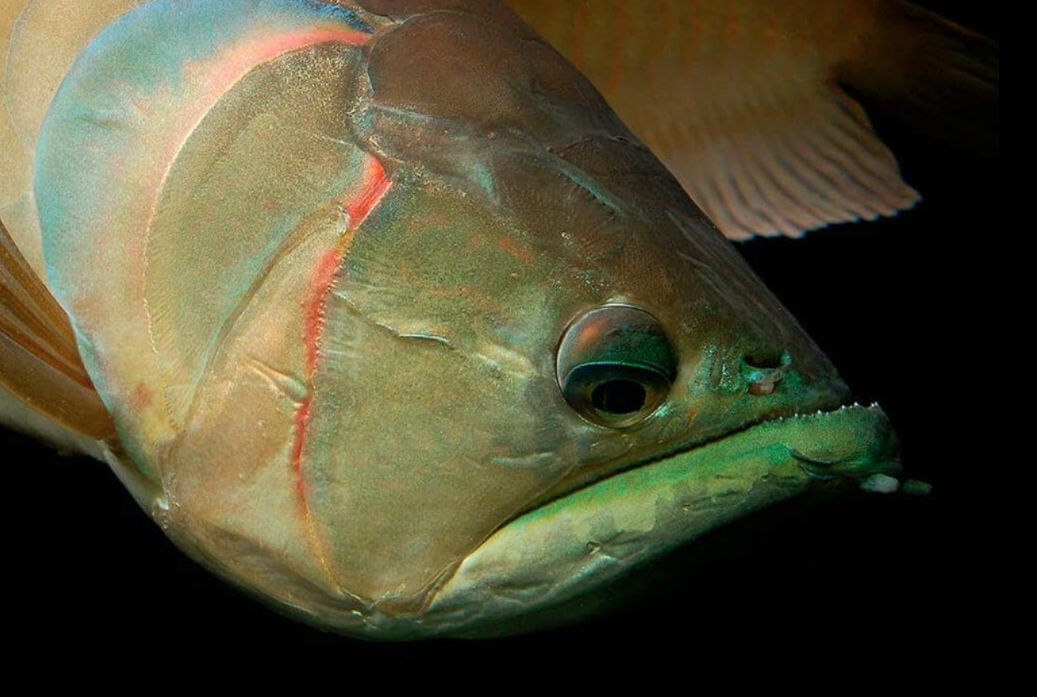
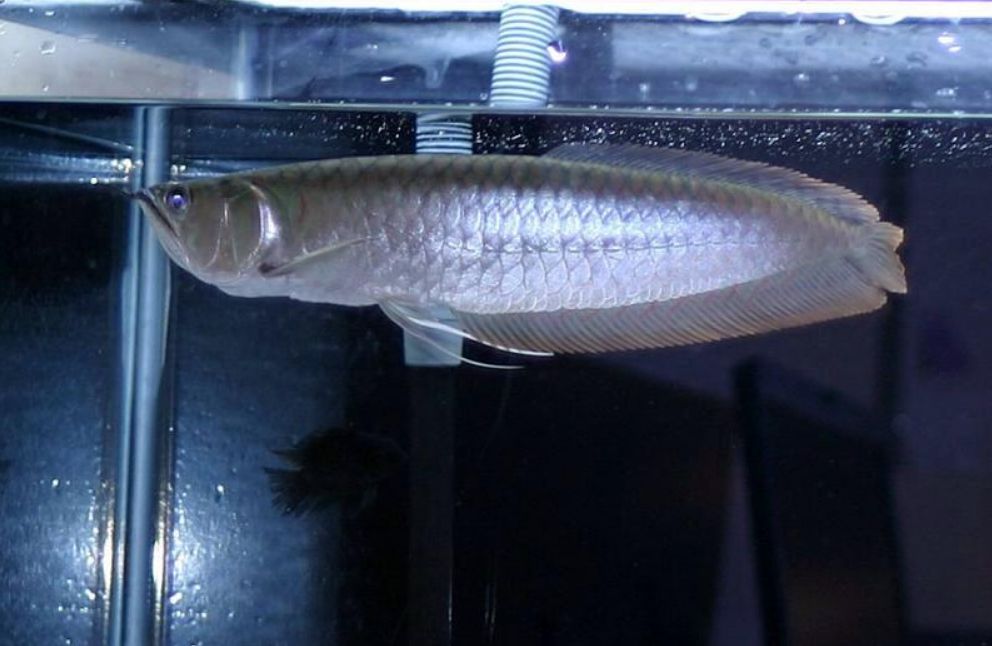
Difficulties in keeping
This fish is definitely not for beginners. Even young silver arowana requires a spacious tank since it grows rather fast. A tank of 250 liters (66 gallons) is enough for young species.
However, rather quickly, the fish will require a bigger tank, about 800–1000 liters (265 gallons). Also, the fish needs very clean and fresh water. However, silver arowana, just like most freshwater fish, is rather tolerant to changes in water pH and hardness.
Besides, feeding silver arowana isn’t cheap.
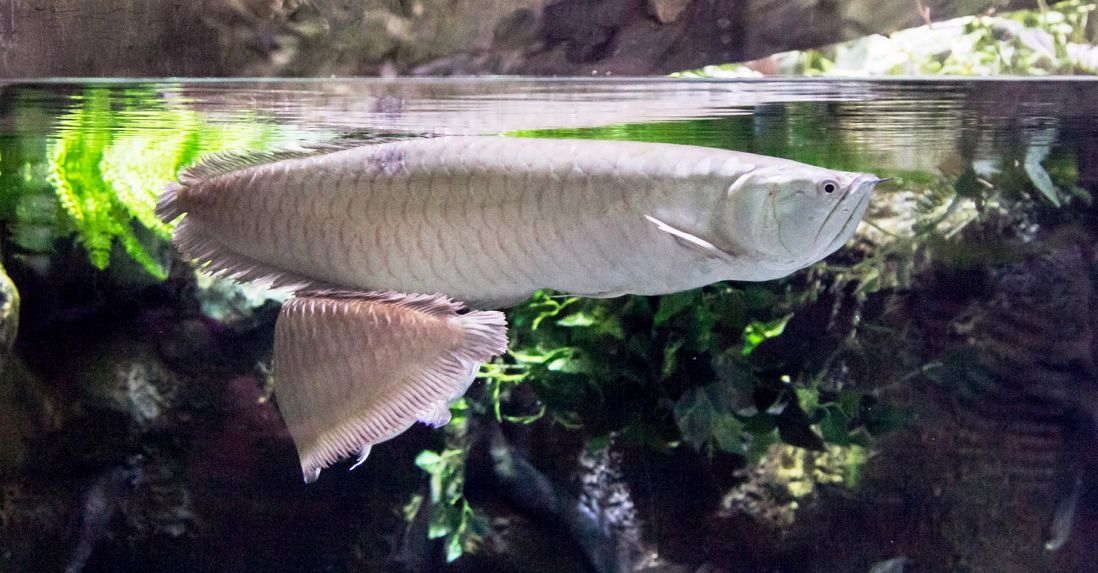
Care and keeping in a tank
Tank size
The most important condition to be observed is to keep this fish in a tank is the tank size. Silver arowanas are large and active fish that require a spacious aquarium to thrive. The tank size needed for a silver arowana largely depends on its age and size. As these fish can grow up to 3 feet (90 cm) in length, providing an adequate tank size is crucial to ensure their well-being and minimize stress.
For juvenile silver arowanas (up to about 6 inches or 15 cm in length), a tank with a capacity of at least 75 gallons (284 liters) would be suitable. As they grow, they will need larger tanks to accommodate their increasing size and swimming needs.
For adult silver arowanas, it is recommended to have a tank with a capacity of at least 250 gallons (946 liters) or more. Some enthusiasts even suggest tanks larger than 500 gallons (1,892 liters) for adult specimens, as this allows them plenty of space to swim and exhibit their natural behaviors.
Minimal tank size is 160 cm long, 60 cm wide, and 50 cm high. This is a very long fish, and it should have the possibility to turn easily in the tank. An ideal tank size for silver arowana has to satisfy the following formula: the tank length has to be at least 3 times larger than the fish length, and the tank width should be not less than 1.2 of the fish size.
It’s acceptable to keep young silver arowana in smaller tanks temporarily. However, later the fish must be taken into a properly sized tank to avoid its body deformation and ensure its maximum lifespan and body length. The tank has to be securely closed with some glass cover to prevent the fish from jumping out of it.
The fish spends time mainly near the water surface, and the tank depth isn’t crucial for it. However, a transparent cover for the tank is a must since silver arowana may instinctively try to catch any insect and jump from the tank.
Water parameters
These fish are sensitive to changes in water quality, so it’s essential to keep the following parameters within appropriate ranges:
- Temperature: The ideal temperature range for silver arowanas is between 75°F to 82°F (24°C to 28°C). Keep the temperature stable, as sudden fluctuations can stress the fish and lead to health issues.
- pH Level: Aim to keep the pH level in the range of 6.5 to 7.5. A slightly acidic to neutral pH is suitable for Silver Arowanas.
- Ammonia and Nitrite: Ammonia and nitrite levels should be consistently at 0 ppm (parts per million). Both ammonia and nitrite are toxic to fish and can cause significant harm.
- Nitrate: Nitrate levels should be kept as low as possible, ideally below 20 ppm. Regular water changes will help control nitrate levels.
- Hardness: Silver Arowanas can tolerate a range of water hardness, but a general guideline is to keep it between 5 to 15 dGH (degrees of General Hardness).
It’s important to test the water regularly using reliable test kits to monitor these parameters. Perform partial water changes (about 20-30%) every one to two weeks to maintain good water quality. Keep in mind that due to their large size and high waste production, Silver Arowanas can be demanding on the filtration system, so ensure you have a robust filter that can handle the tank’s volume.
Additionally, provide a well-aerated environment, as these fish require plenty of oxygen in the water. Providing them with hiding spots and suitable tank decor will also help reduce stress and make them feel secure.
Tank setup: decorations and plants
Actually, this fish doesn’t care much about the tank interior since it spends most of its time in the upper water layer. The tank is usually decorated as its natural biotope. Sand or small pebbles are used as a bottom substrate. Stones and snags are used as decorations. As for the live tank plants, Vallisnéria gigantea is a good choice, but you should surround it with stones so the fish won’t dig it out. The tank lighting shouldn’t be bright. Ideally, you need lighting fixtures that will switch on gradually not to scare the silver arowana.
Filtration
The fish requires strong water filtration, 25-30% water weekly renew, and tank cleaning to keep the proper water characteristics. Silver arowana is tolerant to excessive nitrate content in the tank water, but even a small concentration of ammonia and nitrites is dangerous for it, therefore a canister filter and regular water renews are a must. This large fish produces a lot of waste, and they should be removed from the system.
Diet
Fish hunts mainly close to the water surface. It is an omnivorous one, but it feeds mainly on fish. However, it eagerly catches large insects (mostly bugs), spiders, crabs, snails, frogs, and other small inhabitants, including terrain and tree-dwelling ones, which sit on the branches and leaves above the water, and silver arowana jumps out of the water to get them.
It is said that even snakes and birds were found in arowanas stomachs as well as some plant remnants, which speaks for the fact that the fish really is an omnivorous one.
In the wild, arowanas eat food with a huge amount of bulk substance – such as bird feathers, insects, chitin, etc. It means that you should feed the fish in a tank correspondingly to all those mentioned above. The fish diet may include large insects, shrimps, fish (not more than twice a week), large species may be fed with small animals, for example, mice.
You may also use some special food made for silver arowana. You mustn’t feed the fish with food that drowns all the time since it may cause the fish’s eye focus shifting (cross-eye). In the wild, it spends most of the time scanning the water surface for prey, while in the tank, it will learn to look down if it will be fed with the food that falls on the tank bottom. Some time later, one of its eyes will constantly look down, so-called drop eye.
A large amount of fat food also may cause the same disease because too much fat leads to relaxation of skin structure under the diseased eye. In the wild eyes of healthy fish are directed vertically, not downwards.
Frogs are the favorite food of many silver arowana species. They may get used to it that much that they’ll stop eating any other food. You can buy frogs in a pet shop or on the market.
Feeding with live small fishes will let you observe the process of silver arowana hunting, so it’s not only just some nutritive food for the fish. Such fish should be selected according to the size, so silver arowana would easily swallow them. It shouldn’t be any gorefish, and it shouldn’t have any sharp poisonous pins. Another rule – this must be a tank fish without any infectious diseases.
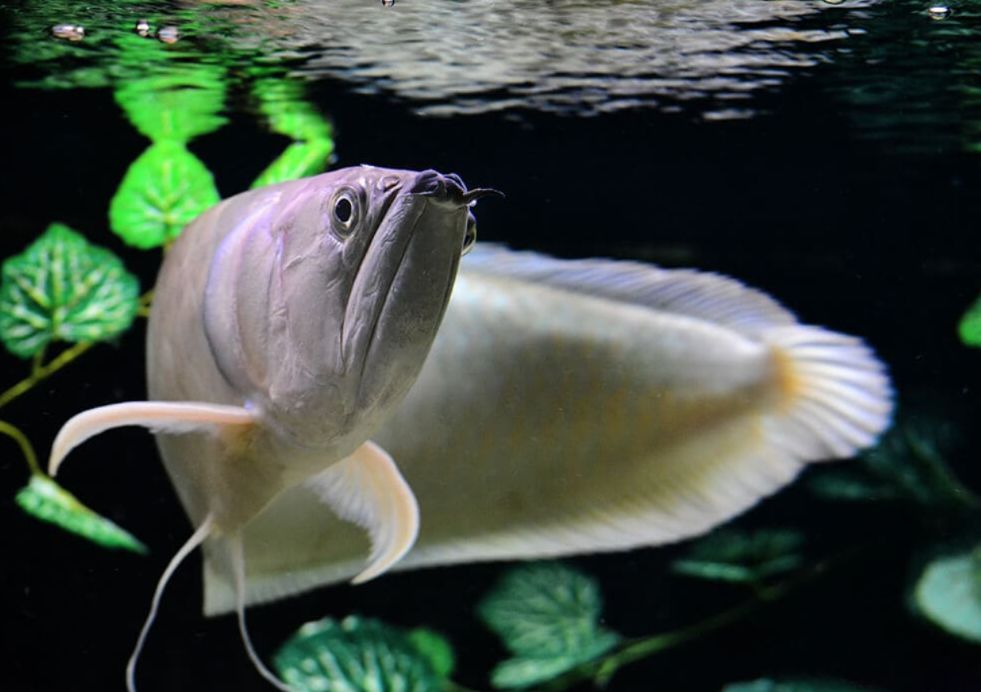
Tank mates
When buying silver arowana to keep it in your tank, keep in mind that this is a predator fish. However, it does well with other tank mates if they are 3 times larger than it is.
Silver arowana can be kept together with black ghost knife fish, blood parrot, oscar fish, flowerhorn, large clown loach, black pacu, giant gourami, plecostomus). However, any smaller fishes, for example, african cichlids and goldfishes, will be treated as food. If you wanted to keep arowana and angelfishes, I wouldn’t opt for this. Arowana won’t eat large angelfishes, especially altum angelfish, but it may eat smaller ones.
There should be no more than one adult silver arowana in a tank since this fish tends to be aggressive to the species of its kind. Wild arowanas demonstrate strongly marked hierarchy when a dominating species selects and occupies a specific territory and attacks any relative that tries to come close. For this reason, adult arowanas are mostly kept alone to avoid possible conflicts between the species.
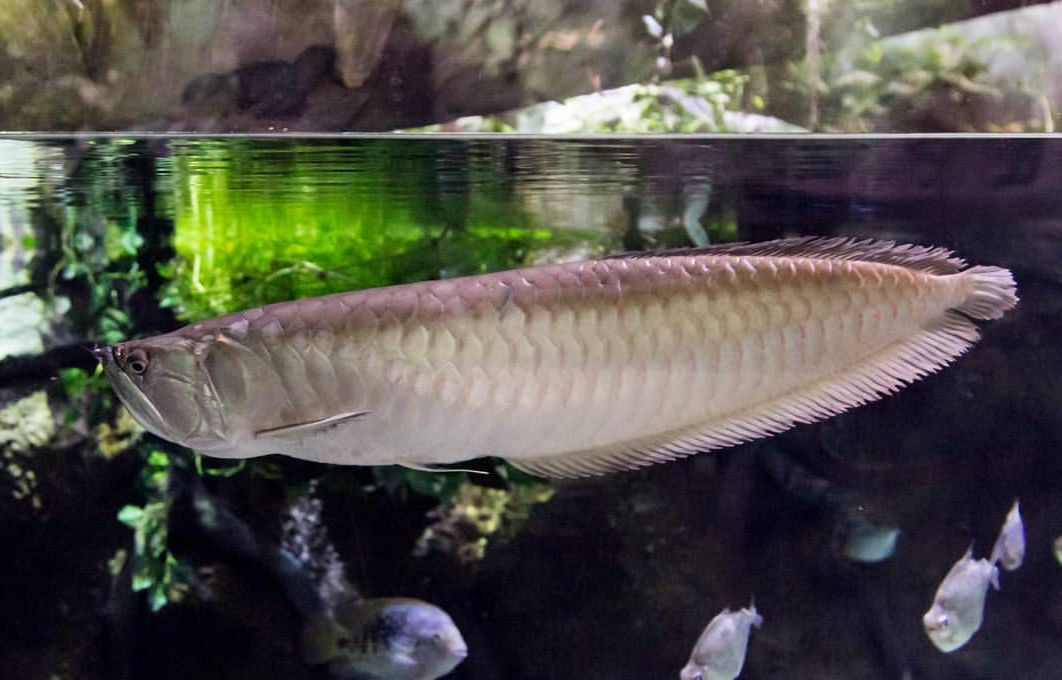
Gender differences: male vs female
Gender dimorphism is rather poorly pronounced here, especially when they are young and not sexually mature. Unlike some other fish species, silver arowanas do not have obvious external sexual characteristics, making it difficult to visually determine their gender with certainty.
As silver arowanas reach sexual maturity, some subtle differences may emerge, but they are not foolproof indicators. These differences may include:
- Size: In some cases, males may grow slightly larger than females, but this difference can be challenging to notice without comparing multiple individuals side by side.
- Body Shape: Males might appear slightly more streamlined and elongated, while females could have a slightly rounder belly due to egg development during the breeding season. However, this distinction is not always apparent.
- Behavior: During the breeding season, males may display more territorial and aggressive behavior as they compete for the attention of females. However, this behavior alone is not enough to identify their gender accurately.
- Breeding Tube: In some cases, sexually mature females might develop a small, fleshy tube called an “ovipositor” near the anal area. However, this feature can be challenging to spot and may not be present in all females.
To reliably determine the gender of silver arowanas, a more definitive method would involve internal examination, such as dissection or endoscopy. However, such invasive procedures are not recommended for typical aquarium hobbyists and are generally only performed for scientific or breeding purposes.
In conclusion, visually distinguishing between male and female silver arowanas can be challenging and may not be possible without internal examination. For most aquarium enthusiasts, the sex of their pet arowana remains unknown unless they acquire them from a source that explicitly identifies the gender through proper documentation or genetic testing.
Breeding
Breeding silver arowanas can be a challenging and complex process. It requires careful preparation, the right environment, and understanding their breeding behavior. Here are some key points to consider if you’re interested in breeding silver arowanas:
- Age and Size: Silver Arowanas typically reach sexual maturity around 3 to 4 years of age. They should be at least 2 feet (around 60 cm) in length before attempting to breed them.
- Pairing: Start by selecting a compatible breeding pair. It’s best to introduce them to each other when they are still juveniles to allow them to form a bond as they grow. Avoid pairing aggressive individuals, as this can lead to potential harm or stress during breeding.
- Breeding Tank: Prepare a dedicated breeding tank that is large enough for the pair to swim comfortably. The tank should have excellent water quality, subdued lighting, and plenty of hiding spots, such as plants or PVC pipes, where the female can deposit her eggs.
- Water Parameters: Maintain stable water parameters within the breeding tank. Silver Arowanas prefer slightly acidic to neutral pH (around 6.0 to 7.5) and water temperature around 78-82°F (25-28°C).
- Conditioning: Before breeding, condition the pair by providing them with a varied and nutritious diet. Live foods, such as insects and small fish, can stimulate breeding behavior.
- Breeding Behavior: Silver Arowanas are mouthbrooders, where the female holds the eggs and fry in her mouth until they hatch. The male initiates the breeding process by displaying courtship behavior, circling the female, and leading her to the chosen spawning site.
- Egg Laying: When the female is ready to spawn, she will lay the eggs on the chosen surface. The male then fertilizes the eggs. After spawning, the female collects the eggs in her mouth, where she will incubate them until they hatch.
- Incubation and Fry Care: The female will carry the eggs and fry in her mouth for several weeks until the fry are ready to swim freely. According to the observations in captivity, male fish incubates the eggs for 40 days. The eggs are very large, red-orange, drop-shaped with a high amount of nutrient substances. During this time, she will not eat, so providing a stress-free environment is crucial. Once the fry are released, they will still seek protection in the female’s mouth when threatened.
- Separation: Arowana juveniles hatch being 3 cm large. After that, they continue staying in one of their parents’ mouths, and they swim out from time to time. Their yolk sac continues to be the source of food for juveniles (they are 6-7 cm long). Young fish leaves its parents’ mouth 5 weeks later since the day it hatched. After the juvenile’s yolk sac comes to an end, they start eating the food you give them. Once the fry are released and can swim independently, it’s essential to separate them from the parents to prevent any potential aggression toward the fry. You can move the fry to a separate rearing tank and feed them with appropriate live or commercially available fry food.
Breeding Silver Arowanas can be a rare event in captivity and requires a significant commitment. It’s essential to have prior experience in fish breeding and be prepared for the challenges that may arise during the process. If you’re a beginner breeder, consider starting with more common and easily bred species before attempting to breed Silver Arowanas.